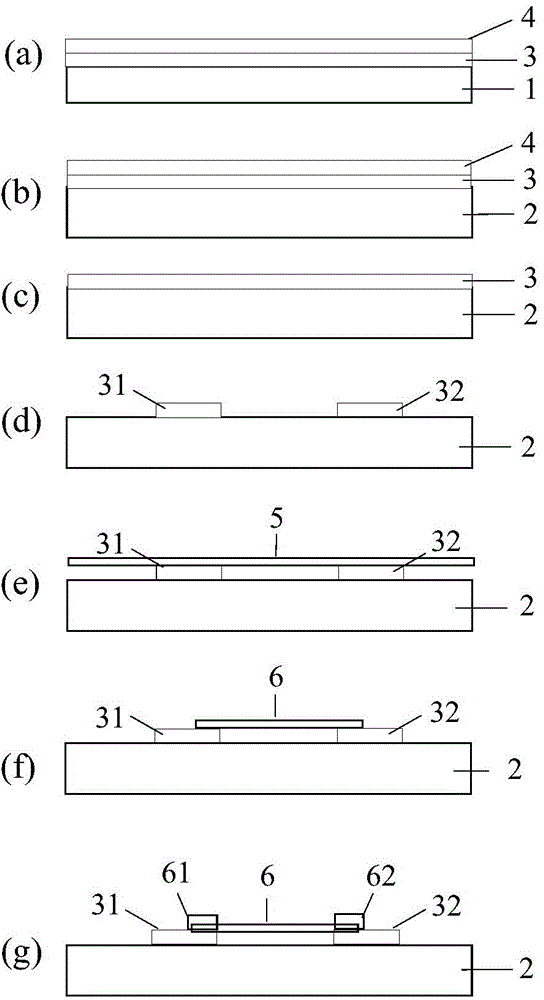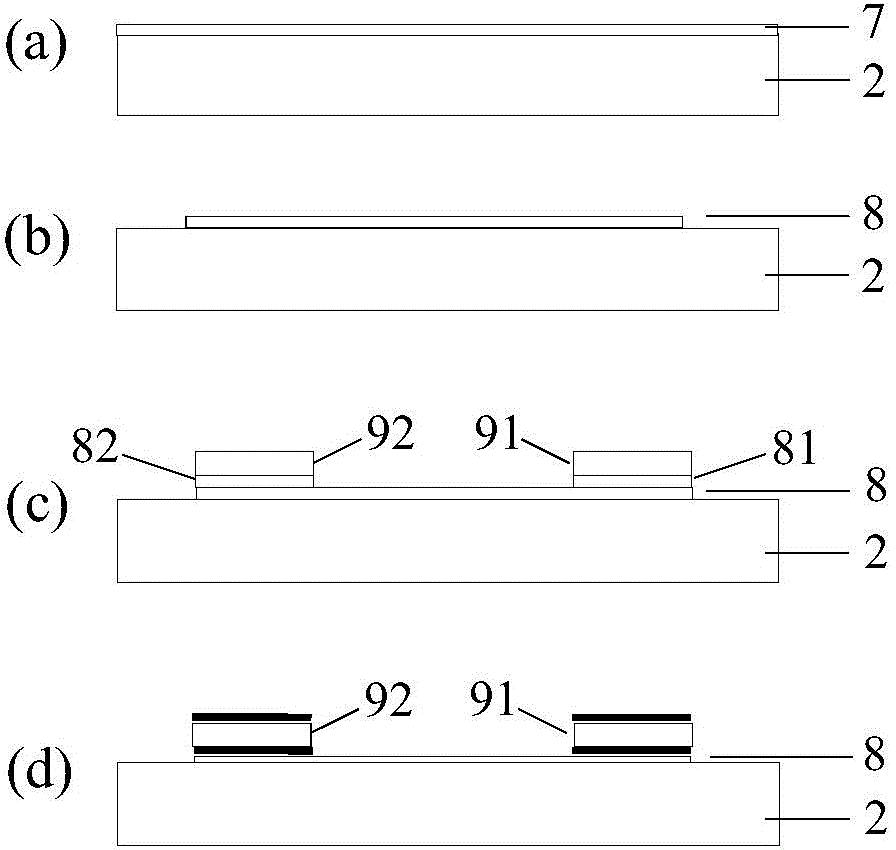Microbubble generator and preparation method thereof
A micro-bubble generator and carbon nanotube technology, applied in the field of micro-electromechanical systems, can solve the problems of easy corrosion and high power consumption, and achieve the effects of not easy electrolysis or corrosion, prolonging life, and improving frequency response.
- Summary
- Abstract
- Description
- Claims
- Application Information
AI Technical Summary
Problems solved by technology
Method used
Image
Examples
preparation example Construction
[0025] Such as figure 1 Shown, the preparation method of the microbubble generator of an embodiment of the present invention comprises the steps:
[0026] (1) Spin-coat a layer of polymethyl methacrylate (PMMA) 4 on the surface of metal foil 1 grown with graphene 3, such as figure 1 (a) shown.
[0027] (2) Corrode metal foil 1 with ferric chloride or ammonium persulfate solution to obtain graphene 3 protected by PMMA4. After cleaning with deionized water, transfer it to substrate 2 cleaned by standard CMOS process, heat treatment to make graphite ene 3 is tightly bound to the substrate 2, as figure 1 (b) shown.
[0028] (3) Soak in acetone to remove PMMA4, and obtain graphene 3 transferred to substrate 2, such as figure 1 (c) shown.
[0029] (4) Graphene electrodes 31 and 32 are obtained by photolithography and reactive ion etching, such as figure 1 (d) shown. The distance between the electrodes is 1-8 μm. If the distance is too small, it is easy to cause a short circui...
Embodiment 1
[0045] The preparation method of microbubble generator comprises the steps:
[0046] (1) Spin-coat a layer of PMMA with a thickness of about 200 nm on the surface of copper foil with single-layer graphene growth.
[0047] (2) Etch the metal foil with 0.5mol / L ammonium persulfate solution to obtain PMMA-protected graphene, wash it with deionized water for 3 times, transfer it to the substrate cleaned by the standard CMOS process, and dry it Bake at 150°C for 10 minutes to make the graphene tightly bonded to the substrate.
[0048] (3) Soak in acetone for 1 hour to remove PMMA and obtain graphene transferred to the substrate.
[0049] (4) Two graphene electrodes were obtained by photolithography and oxygen plasma reactive ion etching with an electrode spacing of 1 μm.
[0050] (5) Covering Cu 2 O nanoparticles, with Cu 2 O nanoparticles as catalyst, methane gas as carbon source, using low-pressure CVD process, heating up to 800°C at a rate of 50°C / s, and growing horizontally...
Embodiment 2
[0054] The preparation method of microbubble generator comprises the steps:
[0055] (1) Spin-coat a layer of PMMA with a thickness of about 200 nm on the surface of copper foil with single-layer graphene growth.
[0056] (2) Etch the metal foil with 0.5mol / L ammonium persulfate solution to obtain PMMA-protected graphene, wash it with deionized water for 4 times, transfer it to the substrate cleaned by the standard CMOS process, and dry it Bake at 150°C for 10 minutes to make the graphene tightly bonded to the substrate.
[0057] (3) Soak in acetone for 1 hour to remove PMMA and obtain graphene transferred to the substrate.
[0058] (4) Two graphene electrodes were obtained by photolithography and oxygen plasma reactive ion etching with an electrode spacing of 8 μm.
[0059] (5) Covering Cu 2 O nanoparticles, with Cu 2 O nanoparticles as a catalyst, methane gas as a carbon source, using a low-pressure CVD process, the temperature was raised to 950°C at a rate of 50°C / s, an...
PUM
| Property | Measurement | Unit |
|---|---|---|
| thickness | aaaaa | aaaaa |
| thickness | aaaaa | aaaaa |
| thickness | aaaaa | aaaaa |
Abstract
Description
Claims
Application Information
 Login to View More
Login to View More - Generate Ideas
- Intellectual Property
- Life Sciences
- Materials
- Tech Scout
- Unparalleled Data Quality
- Higher Quality Content
- 60% Fewer Hallucinations
Browse by: Latest US Patents, China's latest patents, Technical Efficacy Thesaurus, Application Domain, Technology Topic, Popular Technical Reports.
© 2025 PatSnap. All rights reserved.Legal|Privacy policy|Modern Slavery Act Transparency Statement|Sitemap|About US| Contact US: help@patsnap.com


